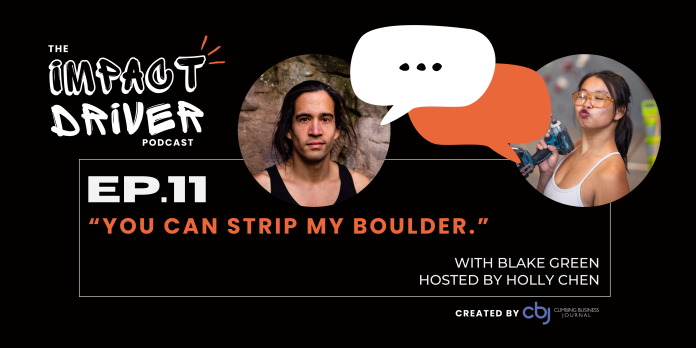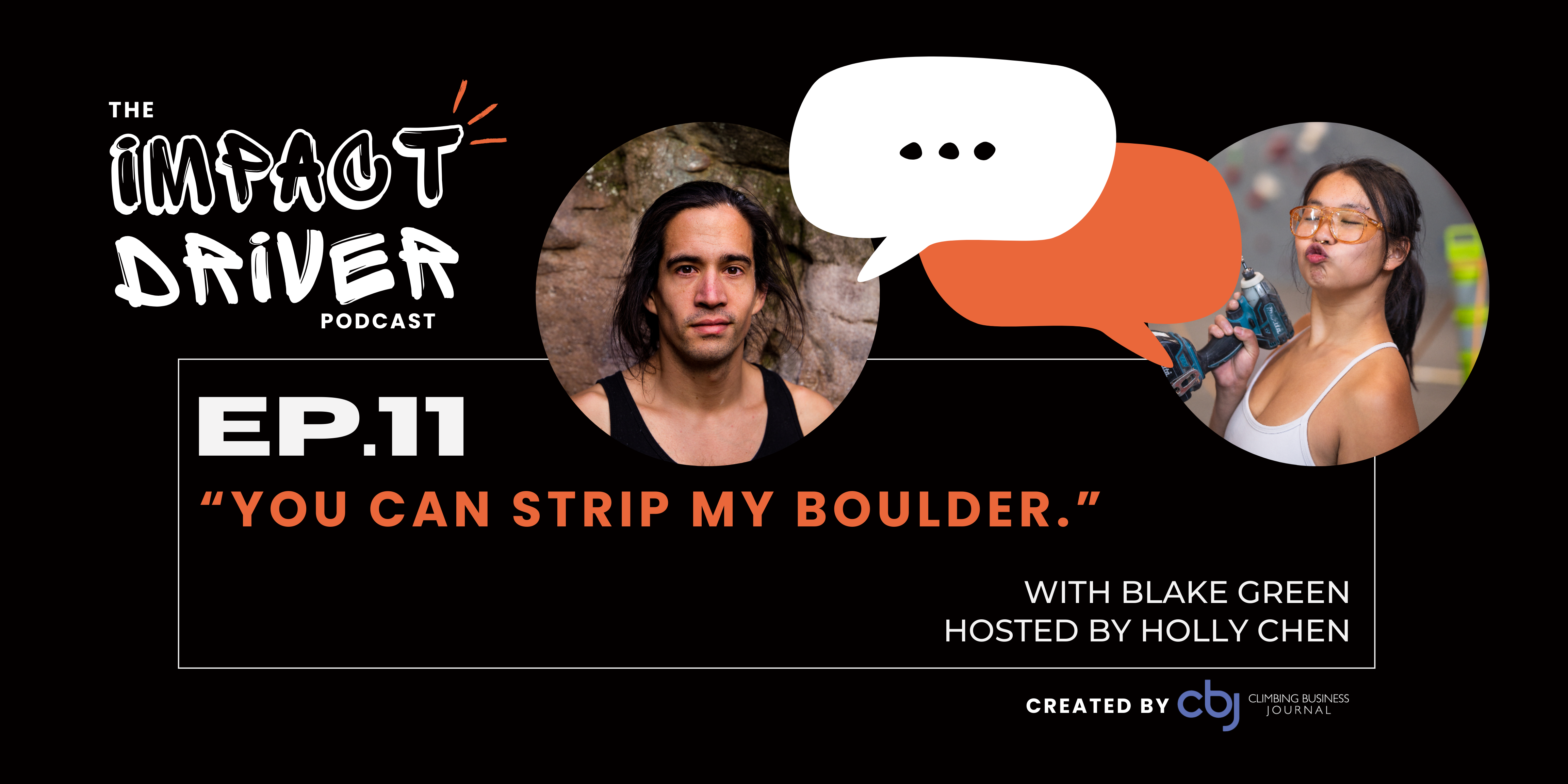
On this episode of the Impact Driver Podcast, host Holly Chen talks with Blake Green. Blake is the head setter at the High Point Climbing and Fitness gym in Birmingham, Alabama. A veteran of the craft with over a decade of routesetting experience under his belt, Blake is a USAC Level 4 routesetter and has set for everything from qualifier to national-level USAC youth competitions. In his spare time, he loves to read and develop routes in his home of the American Southeast.
Blake studied philosophy for both his undergraduate and master’s degrees, so he brings a novel perspective to routesetting, his passion for which is conspicuous. Blake and Holly look at routesetting and climbing culture through the lens of social theory, behavioral economics, and how one defines success as a routesetter. They discuss several books in today’s episode, with Blake outlining the main concepts covered. The pair also talked about different kinds of learning environments, the “10,000-Hour Rule,” and the adaptation of social theory to diverse routesetting crews. Blake talks about the mistakes he made over the years and how they shaped his perception going forward. And Blake and Holly get into the weeds on specific moves, competitions, and the limits of the USAC system.
We hope you enjoy this episode of the Impact Driver Podcast!
Thank you EP Climbing and Rock Gym Pro for your support!
And thank you Devin Dabney for your music!
Timestamps
00:00 – Intro
03:33 – Social theories
05:40 – Outliers by Malcolm Gladwell
06:40 – The 10,000-Hour Rule
11:15 – Routesetting learning environments
17:55 – Men setting for girls
21:46 – Women quitting sports
22:58 – Testing athletes
28:04 – Run and jump lead starts
32:25 – Introducing new moves
41:15 – Success in routesetting
49:42 – Who is successful and why
52:21 – Definition of success
56:41 – Measuring success
01:01:15 – Setting mastery and success
01:06:13 – The Matthew Effect
01:08:43 – Being the wild card
01:15:30 – Closing
Abridged Transcript
…So Blake, can you start by telling us a little bit about some of the social theories that you’ve been reading?
Yeah, so I guess a little bit of background is, in school, I studied philosophy. And that sounds boring—you know, people imagine old white guys with beards—but I tell people that my degrees are in critical thinking, so I get to use them every day. A lot of the things that I’ve been reading lately would kind of fall under the categories of social psychology, or a term I learned more recently is behavioral economics, which I didn’t know was a whole genre. And definitely there are a couple things that are kind of weird, but then there are some that are actually pretty good that I think are actually digestible and that I recommend to coaches and routesetters and my team parents of kids that I coach all the time.
And one of those is Outliers by Malcolm Gladwell, and another one is Range by David Epstein. And those two books are really terrific books for kind of just giving people a comprehensive idea of what it means to be successful, where success comes from, and understanding that the whole idea of success within our culture is actually really complicated. And the TLDR is that really no one is successful in a vacuum. And people that we think of as highly successful ultimately have much more complicated stories than the very simple ones we see on the media or that we tell ourselves…
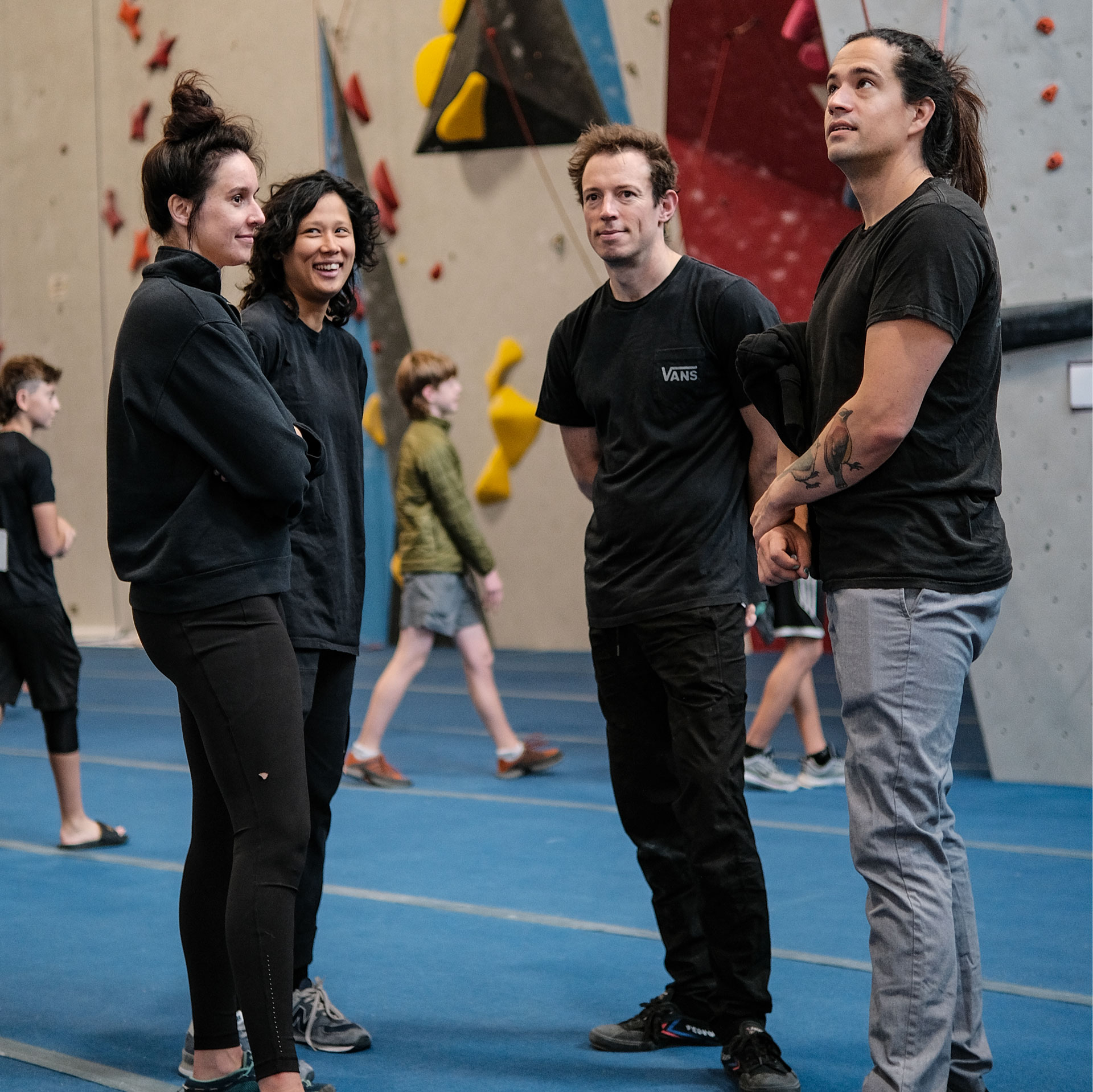
Gladwell discusses the idea that achieving mastery in any field requires approximately 10,000 hours of deliberate practice. And I sat down, and I did the math: How long have I been setting? And this is the best estimate, because obviously I can’t get every single hour involved, but I’ve only roughly set for 6,500.
Man, I know I’ve set more than 10,000 hours. I mean, I’ve been setting for 12 years at this point, and I’ve been setting full time since I’ve been setting—full time for 10 of those 12 years. So, 30 or 40 hours a week on average for those years. It’s interesting that Outliers is one of the books largely credited in our cultural zeitgeist as coming up with this 10,000-hours rule. And he is citing a couple of different, very interesting studies in that book. But another book that I think is really important, and I think is a really good companion to Outliers, is Range by David Epstein.
In Range, David Epstein makes the point that 10,000 hours, or roughly 10,000 hours, is a good metric for achieving expertise and things that fit what we would call “a kind learning environment.” So, a kind learning environment is a type of skill—like playing an instrument or golf are really good examples—where the factors are relatively known that I can engage in. And this 10,000-hour rule applies to deliberate practice. So, I can engage in deliberate practice, and just by trying to do this thing with the intention of getting better for roughly 10,000 hours, I can achieve expertise. So, in a kind learning environment like chess, where all the information is known, or playing an instrument, I can try, I can make a mistake, I can immediately see the results of my actions.
What’s important, that distinction of kind learning environments, [is that] some psychologists like Daniel Kahneman and Robin Hogarth juxtaposed it against wicked learning environments. And a wicked learning environment is much more complicated, where not only is all the information not known, but there’s not an immediate feedback system for: “How did my decision pan out?” And routesetting is really interesting because there are some elements of it that might be kind. I can set this boulder, I can have all these ideas, we can forerun, we can make all these decisions about how it works for our community, I can put it on the wall and then I can watch people climb it. So in that context, I think setting is actually a very kind learning environment. And I think commercial setting looks like a kind learning environment, where 10,000 hours, give or take, is going to make someone a pretty expert commercial setter…
But I’ve been thinking a lot about competition setting, and the kind of decisions when we’re setting for a competition field, and especially in a competition with multiple rounds—qualifiers, finals. And I think competition setting actually looks a lot more like a wicked learning environment, because we are trying to make more specific decisions with even more specific outcomes and there’s always imperfect information. Because as much as we think we know about the competitors, we never have access to what is going on in their mind. The amount of information, processing, decisions, nerves or things that are going on in the competitor’s mind and the way those things pan out in an event actually make competition much more of a wicked learning environment, and I think the 10,000-hour rule is much flimsier in the competition realm…
So you’re saying that, essentially, setting in itself has multiple different types of learning environments, that some can be kind and some can be wicked, and that the 10,000-hour rule may not apply to a comp setter and a commercial setter?
Yeah, I think that’s really true. One of the reasons why I think Range and Outliers actually go really well together is because, in Range, Epstein talks a lot about how in wicked learning environments there are a lot of different attributes that can lead to solving the specific types of problems that come up. And one of the things that’s really interesting is that in numerous fields—from engineering to the many studies of this in hospitals to judges determining who should get out on bail—there are too many studies to count on experts actually being relatively bad at making good decisions. And there are also plenty of contexts in which experts are very good at making decisions in their narrow field of expertise but are very bad at making decisions about novel problems, problems they haven’t seen before, or problems that they’re not as well equipped to deal with. And that is a hallmark of wicked learning environments, is that there are novel problems, or there are problems that will arise because there’s imperfect access to information.
One of the points that is made really well in that book is that one of the ways to get around how bad we are at dealing with uncertainty, just as humans, is actually by having teams of people with diverse backgrounds and diverse experiences, and that having a bunch of different people who come from different backgrounds and who don’t all have expertise in the same thing, they can actually solve those problems way better. And one of the interesting things that I’ve found in building [routesetting] crews I’ve chiefed over the last several years is valuing different backgrounds and people coming into the events without the tradition pedigree, like USAC Levels…
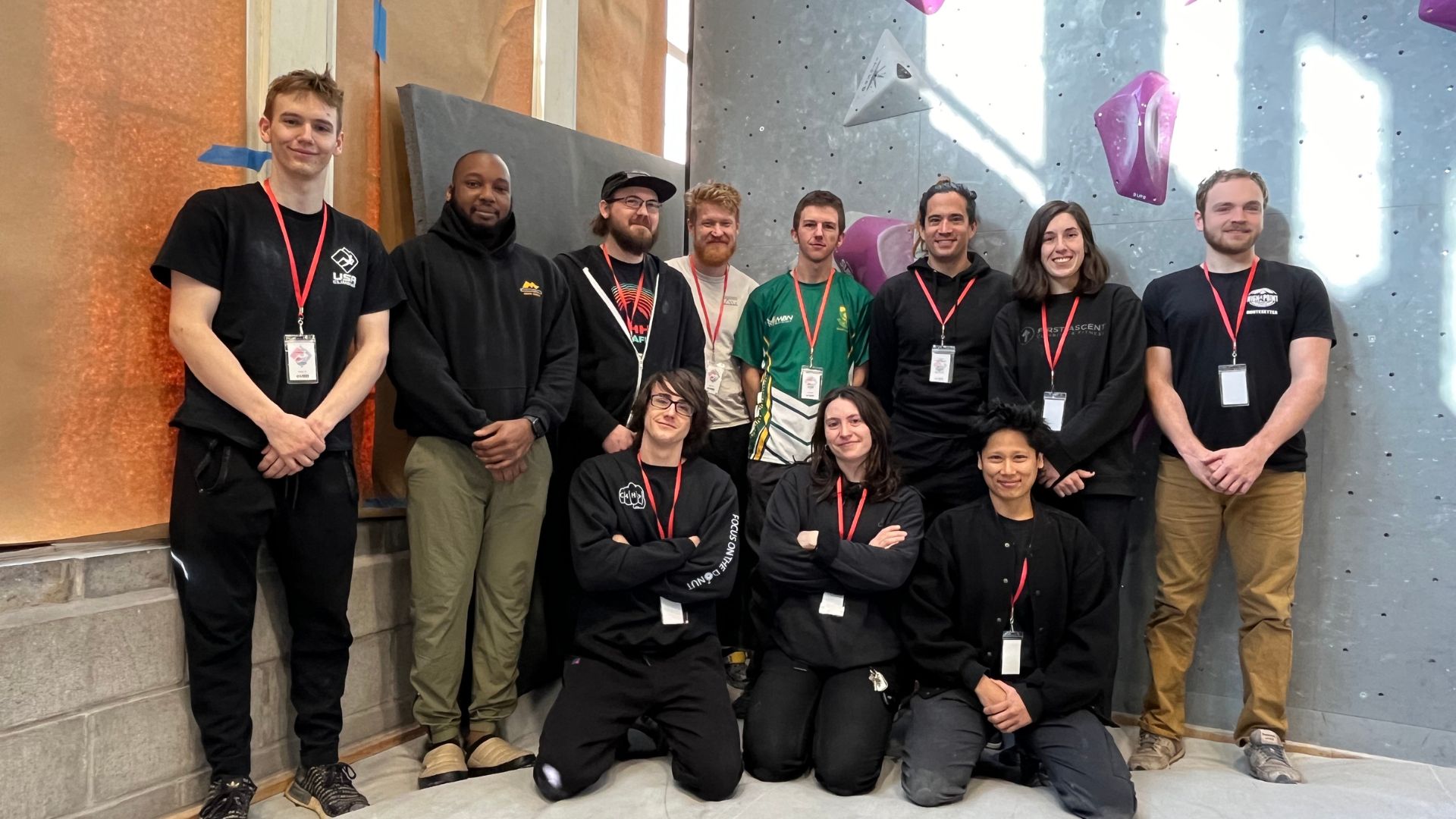
…Going back to the regionals, there was a route that got put up, and some of the concerns surrounding it were like, “Well, you know, it really plays to their strength, it plays to their flexibility, their ability to potentially break beta if you have a different body type and find a different way around it.” And we were wondering whether or not to tweak the route into something that would really test things that are stereotypically not in a woman’s route, which are maybe power or thugginess and things like that. And the result was that we didn’t tweak it into something that is in the power range. We just turned up what we would be testing in terms of their strengths: “You are flexible, you can break beta. Okay, how far can you take that? If you can take it really far, you win. If you can’t take it really far, then great, you end your season on a high, on a route that you know you’re going to do well on, and you move on to collegiate, hopefully.”
I think that’s a really cool way to approach a climb like that, saying, “Let’s actually, if we’re going to test their strengths, let’s find out where the limit is.” I think that’s really cool. And honestly, when you started talking about an experience you had at a recent regionals, I thought you were going to tell an opposite story, which I have in my mind, I think about this all the time: I was setting a regionals where, because of space constraints, the Female B and A and Junior had to be stacked on the same routes, and same with Male A Junior. And that usually goes rough for the B categories when that happens.
But I went into it thinking, “I have a hypothesis that a lot of coaches, especially because most coaches are men—at least at that point, eight years ago—I think a lot of these coaches are not actually coaching their girls to jump as readily or as willingly or as much of an automatic solution to problems as they are to boys. I think that some of these assumptions of girls and boys’ climbing styles are getting baked in socially.” And so, I set this jump on the Female B A Junior route that wasn’t that hard, it was essentially to a volume that was like a jug. And I was like, “Cool, I’m going to see which of the coaches are just making sure that their girls are comfortable jumping.” Unfortunately, I set the move horribly…The move backfired heinously. It was this horrible bottleneck, and because it was in this lead area that’s dug down into a pit, they were almost at eye level with all the spectators. It was horrible. The route went super bad.…
A month later, I was setting divisionals for that same crop of kids, one event up. And a coach from one of the teams comes up to me and is like, “Hey, did you set that white route for the Female B A Juniors at regionals?” And I was like, “Oh, no, I’m about to get so much shit for this.” And I’m like, “Yeah, that was me.” And he’s like, “Hey, thank you for setting that because it looked like a bottleneck in the comp, but we all came away from that on our team, all of our coaches, and we sat down and we made sure, went through and drilled dynoing on lead for our older girls after that happened.” And I was like, “Whoa…”
Okay, let’s take this a little bit further. I can’t remember off the top of my head which comp this was, but I believe this was a team trial some time ago, someone zero-scored on a route for women for run and jump. And this run and jump, if I remember correctly—I’m going to fact-check this after this episode—is a straight upward dyno off of some volume of some kind, and that route was set by men, I believe.
So, you’re bringing up Team Trials at Stone Summit Atlanta in 2022, I believe. And it affected several climbers, but Norah Chi is the climber that most people remember it affecting. Because Norah is a terrific climber, and she was climbing so well at the time, she was expected to be in contention for the National Team at the 2022 Team Trials at Stone Summit in Atlanta. And so that was an example, it was really interesting, because yeah, that route was set by men, and I think any number of things about that move could have been done differently or better. But I think one of the things that made that impactful was that it was in a single-route round. And at that point, we hadn’t seen very many dynamic starts, especially within USA Climbing on semifinals or finals rounds. And so, when there’s that really harsh result, and that’s people’s first interaction to it or introduction to seeing something like that, and it looks like it’s backfiring, then it’s easy to be very critical of the setting team. And my only criticism at the time was just that it feels like we miss things like this for the women’s round more than the men’s round…
I want to go back to success a little bit, because let’s say we take [the friend and colleague you mentioned] as a definition of someone who is successful in routesetting culture, community, career. Can we bring that back into talking about the specifics of the definition of success and why we see someone as being successful in routesetting?…
…I think to some degree it’s just really easy for us to tell ourselves that success is equal to notoriety. How well-known someone is is a token of how successful they are, which I think in a lot of cases is true, but in a lot of cases it’s not true on the opposite side. Other people might be very successful and we don’t know them…What is the metric? Is the metric successful in the industry? And by that I just mean are they still here after ten years, or did they pack up and go home? Because a lot of wonderful routesetters who I love and admire have left the industry. Is success just hanging in there? Is success getting perfect separation at every comp? It’s probably not…Is success leveling up in the USAC system?…I do think we have a lot of ways to expand on and grow the idea of success…
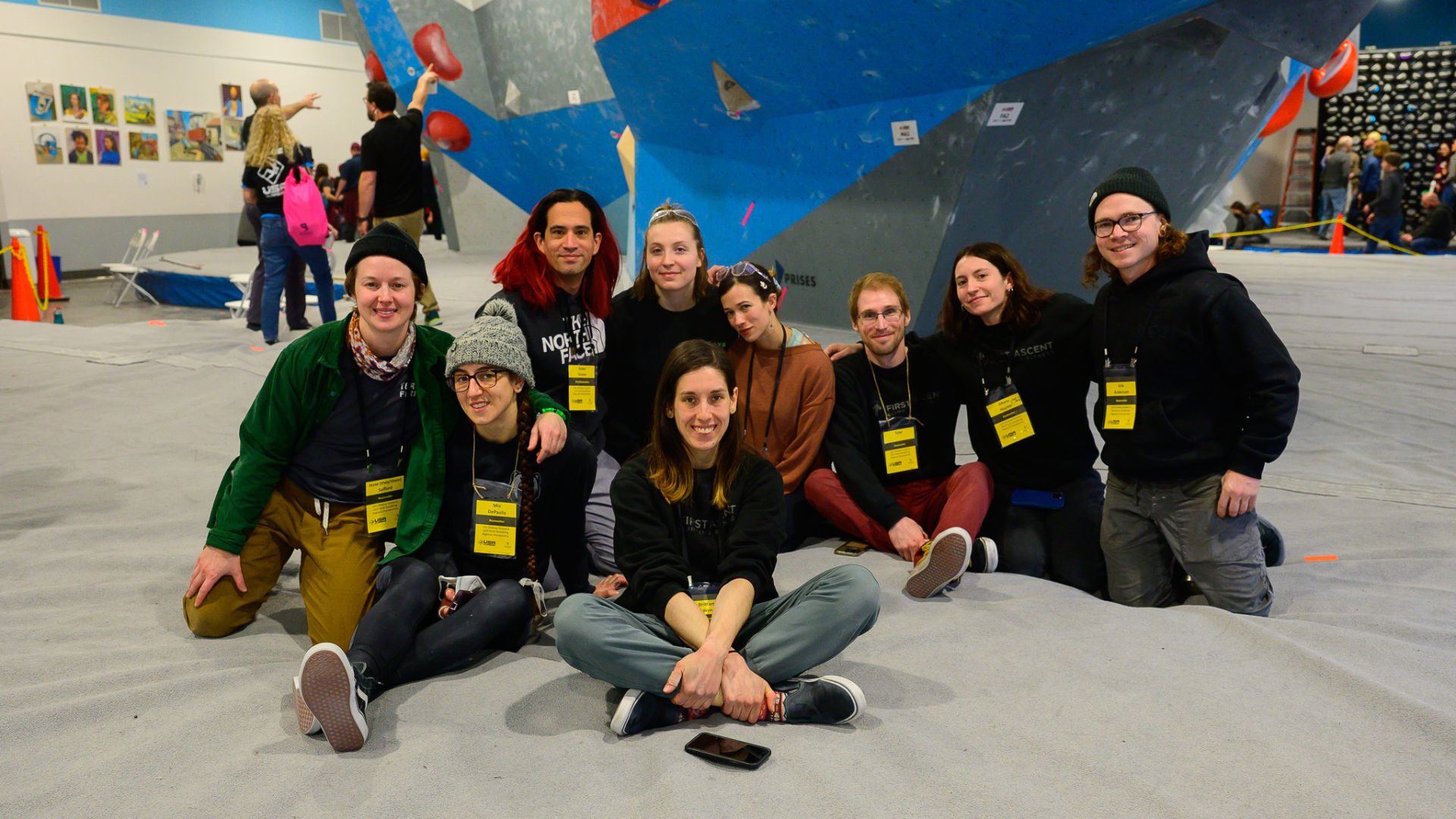
…In the wider system, do you have any idea of what kind of solution we can be working toward to shift that measure of success from these traditional factors of separation into something that’s a little bit more sustainable for both the routesetters and the climbers who they’re setting for?
I think that’s a really complicated question. I do think to some degree it’s like, yeah, Colin Duffy shows up, and I think that success is measurable in the sense of being good marketing material. But again, I think it just depends on what your or the event’s goal is. I think success is going to be event dependent. So, if this event is a youth comp versus if it’s a cash-purse comp versus if it’s a community comp, I do think in some way success for that event will always be indexed to who it’s for. And then I think, beyond that, the chief of the event does get to decide a lot of what success looks and feels like for the crew…
Another point that I want to talk about from Outliers is that the author emphasizes successes. And you talked about this very briefly, how success does not exist in a vacuum, it’s determined by a bunch of different factors, not just individual effort. We all want to think that, “If I work hard, I can definitely be successful,” but that’s not always the case, especially in a field like routesetting. Can you kind of describe for us what I think is the “Matthew Effect” in Gladwell’s book?
So, the Matthew Effect is basically the idea that people will accrue success in accordance with accruing popularity or social acceptance. And I think it’s really common in routesetting, and I think it’s really apparent—I don’t think it’s news to anybody that certain people are always on crews together. I think if someone feels frustrated watching it happen from the outside, I think that frustration is really valid…
One of the things that I try to do [as a crew chief] besides bringing in [a more diverse crew] is a lot of those things that you’ve expressed. A lot of those fears [in being the “wild card” on a crew] come from being in some sort of toxic environment where there’s this perception of failure as a bad thing. And I try to tell everybody that literally everything that I can do really efficiently and really fast is one or multiple heinous f*** ups. In all of my crew meetings, one of my commoner frames is: “The reason I’m chiefing this event is because I have made more mistakes than everyone else here.”
So, if the couple people who are my “sure things”— who are my strongly referenced people that I’ve worked with in one or two events—I’m bringing those people in, and then I’m bringing in wild cards. And if my assistants who I’m bringing in all are on the same page, drinking the same Kool Aid of, “Yeah, we can f*** up, you can strip my boulder,” whatever it is—if I’m modeling that, and they’re modeling that, then all of a sudden, everyone else on the crew is like, “Oh, I can f*** up [too].”
…I’ve had enough climbs stripped that I’ve learned a lot of good strategies to avoid it. But one of the other things that I’ve done in a couple boulder comps where I was chiefing with largely unknown people is I’ll set really fast. I’ll put a lot of skeletons on the wall really quickly. As the chief, I’ll set a total placeholder skeleton that I know is not good but was a style and I’ll say, “Hey, forerun that boulder last.” And then when they come around, I’ll say, “Oh yeah, strip my boulder.” And they’re like, “What?” I’m like, “Yeah, strip it. It’s stupid.” And there’s just something so liberating about, “My idea as a chief is no more sacrosanct than anyone else’s. Just take it down, throw it away, put something good on the wall.” That can break the ice really fast on day one. And I’ve found other, often better, faster ways of doing things than that, but that way always still works…

Holly grew up in Taiwan and Hong Kong. Now she lives in Denver where she reports, writes and routesets. Beyond the Climbing Business Journal, her writing has been published by Alpinist Magazine, Climbing Magazine, Gym Climber and Sharp End Publishing. Holly’s motto has always been: “keep it interesting.”
Read our interview with Holly: Storytelling Through Movement




